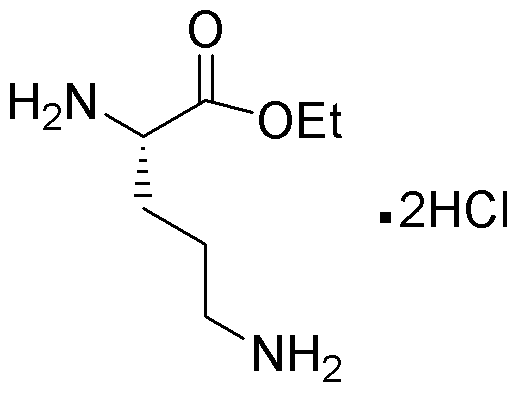L-Ornithine ethyl ester dihydrochloride is widely utilized in research focused on:
- Sports Nutrition: This compound is often used in dietary supplements aimed at enhancing athletic performance and recovery by supporting muscle metabolism and reducing fatigue.
- Wound Healing: It plays a role in promoting tissue repair and regeneration, making it valuable in formulations for topical treatments aimed at accelerating healing processes.
- Liver Health: Researchers explore its potential in supporting liver function and detoxification, particularly in conditions like hepatic encephalopathy.
- Neuroprotection: Studies suggest it may have neuroprotective properties, which can be beneficial in developing treatments for neurodegenerative diseases.
- Cosmetic Formulations: Its ability to enhance skin hydration and elasticity makes it a popular ingredient in anti-aging skin care products.
General Information
Properties
Safety and Regulations
Applications
L-Ornithine ethyl ester dihydrochloride is widely utilized in research focused on:
- Sports Nutrition: This compound is often used in dietary supplements aimed at enhancing athletic performance and recovery by supporting muscle metabolism and reducing fatigue.
- Wound Healing: It plays a role in promoting tissue repair and regeneration, making it valuable in formulations for topical treatments aimed at accelerating healing processes.
- Liver Health: Researchers explore its potential in supporting liver function and detoxification, particularly in conditions like hepatic encephalopathy.
- Neuroprotection: Studies suggest it may have neuroprotective properties, which can be beneficial in developing treatments for neurodegenerative diseases.
- Cosmetic Formulations: Its ability to enhance skin hydration and elasticity makes it a popular ingredient in anti-aging skin care products.
Documents
Safety Data Sheets (SDS)
The SDS provides comprehensive safety information on handling, storage, and disposal of the product.
Product Specification (PS)
The PS provides a comprehensive breakdown of the product’s properties, including chemical composition, physical state, purity, and storage requirements. It also details acceptable quality ranges and the product's intended applications.
Certificates of Analysis (COA)
Search for Certificates of Analysis (COA) by entering the products Lot Number. Lot and Batch Numbers can be found on a product’s label following the words ‘Lot’ or ‘Batch’.
*Catalog Number
*Lot Number
Certificates Of Origin (COO)
This COO confirms the country where the product was manufactured, and also details the materials and components used in it and whether it is derived from natural, synthetic, or other specific sources. This certificate may be required for customs, trade, and regulatory compliance.
*Catalog Number
*Lot Number
Safety Data Sheets (SDS)
The SDS provides comprehensive safety information on handling, storage, and disposal of the product.
DownloadProduct Specification (PS)
The PS provides a comprehensive breakdown of the product’s properties, including chemical composition, physical state, purity, and storage requirements. It also details acceptable quality ranges and the product's intended applications.
DownloadCertificates of Analysis (COA)
Search for Certificates of Analysis (COA) by entering the products Lot Number. Lot and Batch Numbers can be found on a product’s label following the words ‘Lot’ or ‘Batch’.
*Catalog Number
*Lot Number
Certificates Of Origin (COO)
This COO confirms the country where the product was manufactured, and also details the materials and components used in it and whether it is derived from natural, synthetic, or other specific sources. This certificate may be required for customs, trade, and regulatory compliance.


